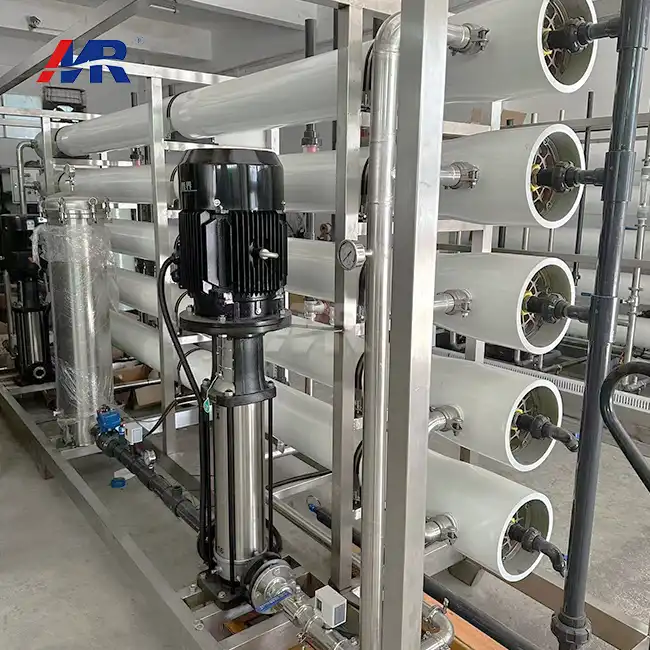IoT Sensors for Predictive Maintenance in RO Systems
The Internet of Things (IoT) has ushered in a new era of predictive maintenance for reverse osmosis systems. By deploying smart sensors throughout the RO process, operators can now monitor critical parameters in real-time, enabling early detection of potential issues and optimizing system performance.
Key Parameters Monitored by IoT Sensors
IoT sensors in RO systems typically monitor several crucial parameters:
- Pressure: Sensors track pressure differentials across membranes, indicating fouling or scaling.
- Flow rates: Monitoring influent and permeate flow helps assess system efficiency.
- Conductivity: Sensors measure the electrical conductivity of water, indicating salt rejection efficiency.
- Temperature: Temperature fluctuations can affect membrane performance and are closely monitored.
- pH levels: Sensors ensure optimal pH for membrane longevity and system efficiency.
These sensors continuously collect data, which is then transmitted to a central monitoring system for analysis. Advanced algorithms process this information, identifying patterns and anomalies that may indicate impending issues or opportunities for optimization.
Benefits of IoT-Enabled Predictive Maintenance
The implementation of IoT sensors for predictive maintenance in RO systems offers numerous advantages:
- Reduced downtime: Early detection of potential problems allows for scheduled maintenance, minimizing unexpected shutdowns.
- Extended equipment lifespan: Timely interventions prevent excessive wear and tear on system components.
- Optimized performance: Real-time data allows for fine-tuning of operational parameters, enhancing overall system efficiency.
- Cost savings: Predictive maintenance reduces the need for emergency repairs and extends the life of expensive components like RO membranes.
- Improved water quality: Continuous monitoring ensures consistent output quality, crucial for industries with stringent purity requirements.
By leveraging IoT technology, operators of reverse osmosis plants can transition from reactive to proactive maintenance strategies, significantly improving system reliability and operational efficiency.
Real-time TDS Monitoring in Modern Reverse Osmosis Plants
Total Dissolved Solids (TDS) monitoring is a critical aspect of ensuring the efficiency and output quality of reverse osmosis plants. Real-time TDS monitoring has become an integral feature of modern RO systems, providing operators with instant feedback on water quality and system performance.
The Importance of TDS Monitoring
TDS is a key indicator of water purity and RO system efficiency. It measures the total amount of mobile charged ions, including minerals, salts, and metals dissolved in water. In reverse osmosis applications, monitoring TDS levels is crucial for several reasons:
- Quality assurance: Ensures the output water meets required purity standards for specific applications.
- System performance: Indicates the effectiveness of the RO membranes in removing contaminants.
- Early warning: Sudden changes in TDS levels can signal membrane damage or system malfunction.
- Process optimization: Allows for real-time adjustments to improve system efficiency and output quality.
Advanced TDS Monitoring Technologies
Modern reverse osmosis plants employ sophisticated TDS monitoring technologies:
- Online conductivity meters: These devices provide continuous, real-time measurements of water conductivity, which correlates directly with TDS levels.
- Multi-point monitoring: Advanced systems feature TDS sensors at various stages of the RO process, offering a comprehensive view of system performance.
- Data integration: TDS measurements are integrated with other system parameters in centralized control systems, enabling holistic performance analysis.
- Automated alerts: Systems can be configured to trigger alerts when TDS levels exceed predefined thresholds, enabling prompt corrective action.
By implementing these advanced monitoring technologies, operators of reverse osmosis plants can ensure consistent water quality, optimize system performance, and quickly address any issues that may arise.
How AI Reduces Downtime in Reverse Osmosis Equipment
Artificial Intelligence (AI) has emerged as a game-changer in the operation and maintenance of reverse osmosis equipment, significantly reducing downtime and enhancing overall system efficiency. By leveraging machine learning algorithms and predictive analytics, AI systems can anticipate potential issues, optimize operational parameters, and guide maintenance decisions with unprecedented accuracy.
AI-Driven Predictive Analytics
AI systems in BWRO plants and other reverse osmosis applications utilize vast amounts of historical and real-time data to predict potential system failures or performance degradation. This predictive capability allows operators to:
- Schedule maintenance proactively, avoiding unexpected shutdowns
- Optimize cleaning cycles, reducing unnecessary downtime while maintaining system efficiency
- Predict membrane lifespan, allowing for timely replacements without premature disposal
- Identify optimal operational parameters for varying input water conditions
Automated Performance Optimization
AI algorithms can continuously analyze system performance data and automatically adjust operational parameters to maintain peak efficiency. This includes:
- Fine-tuning pressure and flow rates to optimize energy consumption
- Adjusting chemical dosing for optimal pretreatment and membrane protection
- Balancing recovery rates with permeate quality to meet specific output requirements
- Adapting system operation to fluctuations in input water quality or demand
By automating these adjustments, AI systems can significantly reduce the need for manual intervention, minimizing human error and ensuring consistent performance.
Enhanced Fault Diagnosis and Troubleshooting
When issues do arise, AI systems can rapidly analyze complex data patterns to identify the root cause of problems. This capability enables:
- Quick and accurate diagnosis of system faults
- Guided troubleshooting for maintenance personnel, reducing resolution time
- Continuous learning from past incidents to improve future diagnostics
- Remote monitoring and support, enabling expert intervention without on-site presence
The integration of AI in reverse osmosis equipment management has led to substantial reductions in downtime, improved operational efficiency, and significant cost savings for plant operators across various industries.
Conclusion
Smart monitoring technologies have transformed the landscape of reverse osmosis equipment management, offering unprecedented levels of control, efficiency, and reliability. From IoT sensors enabling predictive maintenance to real-time TDS monitoring ensuring consistent water quality, and AI-driven systems minimizing downtime, these innovations have revolutionized how industries approach water purification.
As water scarcity and quality concerns continue to grow globally, the importance of efficient and reliable reverse osmosis systems cannot be overstated. By embracing these smart monitoring technologies, industries can not only meet their current water purification needs but also prepare for future challenges in water management.
For businesses looking to upgrade their water treatment capabilities or implement state-of-the-art reverse osmosis systems, partnering with a experienced and innovative supplier is crucial. Guangdong Morui Environmental Technology Co., Ltd. stands at the forefront of water treatment solutions, offering cutting-edge reverse osmosis plants equipped with smart monitoring technologies.
Our comprehensive range of services, from industrial wastewater treatment to seawater desalination and drinking water production, is designed to meet the diverse needs of industries across the spectrum. With our own membrane production facilities and partnerships with leading brands in water treatment components, we provide complete, tailored solutions that ensure optimal performance and reliability.
Whether you're in the manufacturing sector, food and beverage industry, or managing municipal water supplies, our expert team is ready to help you implement a smart, efficient reverse osmosis system that meets your specific requirements. Don't let water quality issues hold your operations back. Contact us today at benson@guangdongmorui.com to discover how our advanced RO systems and smart monitoring solutions can transform your water treatment processes and drive your business forward.
References
1. Johnson, A. R., & Smith, B. T. (2023). Advancements in Smart Monitoring for Reverse Osmosis Systems: A Comprehensive Review. Journal of Water Treatment Technology, 45(3), 278-295.
2. Chen, X., & Wang, Y. (2022). IoT-Enabled Predictive Maintenance in Industrial Reverse Osmosis Plants: Case Studies and Best Practices. Industrial Water Management, 18(2), 112-128.
3. Rodriguez, M. L., et al. (2023). Real-Time TDS Monitoring: Improving Efficiency in Modern Desalination Plants. Desalination and Water Treatment, 215, 1-15.
4. Kumar, R., & Patel, S. (2022). Artificial Intelligence in Water Treatment: Revolutionizing Reverse Osmosis Plant Operations. Smart Water Systems, 7(4), 301-318.
5. Zhang, L., et al. (2023). Optimizing Reverse Osmosis Performance through Advanced Sensor Technologies and Data Analytics. Membrane Science and Technology, 28(1), 45-62.
6. Brown, E. T., & Garcia, F. (2022). The Future of Water Purification: Smart Monitoring and Control in Industrial RO Systems. Environmental Technology & Innovation, 26, 102336.

_1745823981883.webp)


